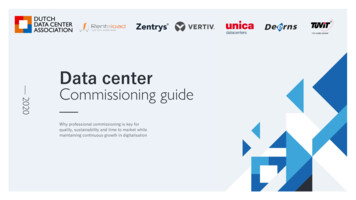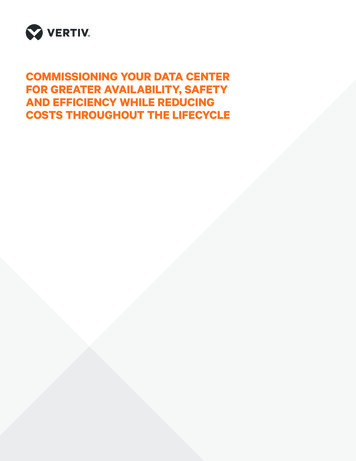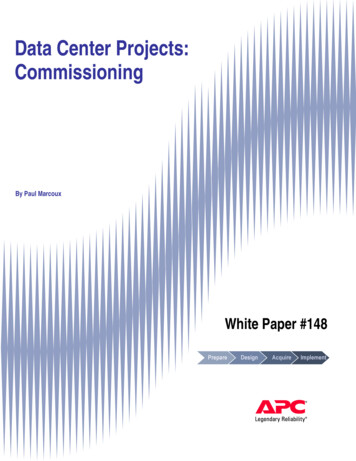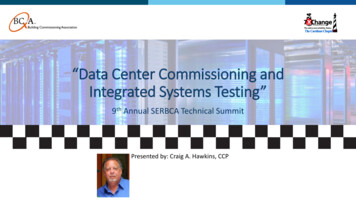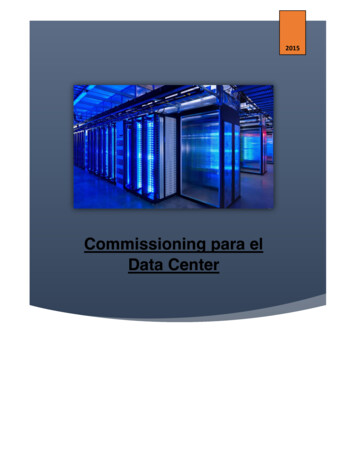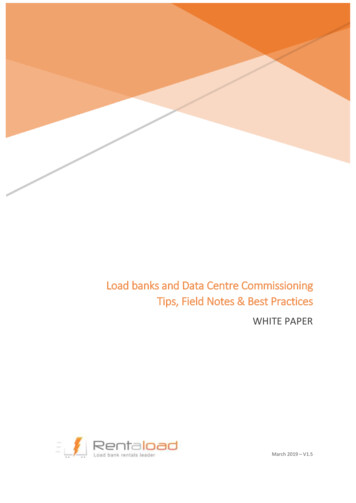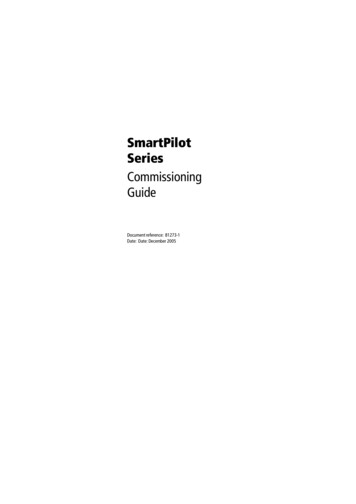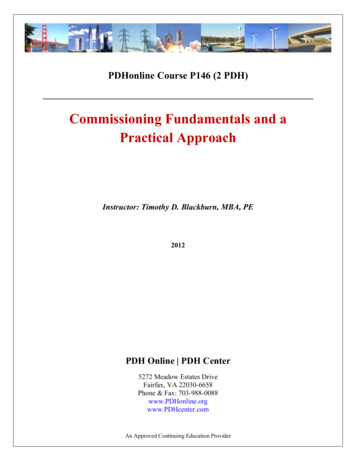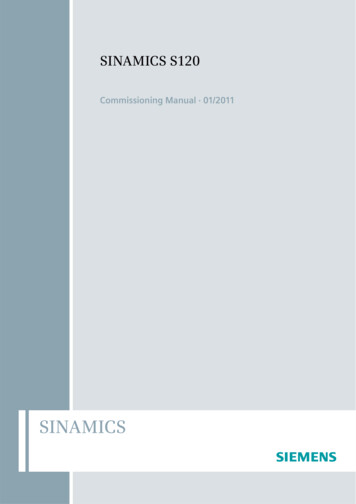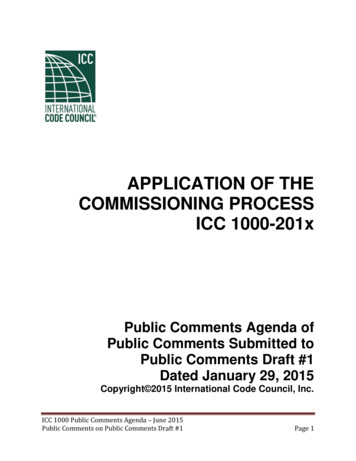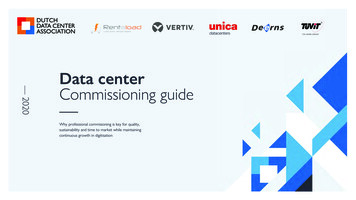
Transcription
— 2020Data centerCommissioning guideWhy professional commisioning is key for quality,sustainability and time to market while maintainingcontinuous growth in digitisation
Content1The digital economy is the economy2Commissioning3Best practises & cases- Appendices; further reading, about, colophon
1.THE DIGITAL ECONOMYIS THE ECONOMY
1.Everything is data drivenEverything is datadrivenThe world is rapidly changingdue to digital transformationData drivenSmartShareAs a Service
1.The digital economy is the economyMore and more revenue throughdigitisation: top priority to go alongwithBy 2022, more than 60% of global GDP1 will bedigitized with growth in every industry, driven ps.Management of each organisation must place digitaltransformation at the top of their priority list. Allthat happens online originates from data centers.
1.Growth in data centers is inevitableDigitisation puts more trust in data centersThe ever-increasing digitization of our society and economy requires more andmore data centers. The speed in digital transformation is putting pressure on thedelivery of new data centers.We need the growth of data centers to also control the use of energy.Centralizing IT in data centers saves energy: Cloud computing brings muchbetter utilization of computer power next to the increased efficiency in runningthe data center facilities.To ensure the quality of new data center facilities while speeding up andinproving the building process at the same time requires professional data centerstandards.Despite the enormous growth in data, energyconsumption has remained stable worldwide
2.COMMISSIONING,BENEFITS & PROCESSES
2.Data Center CommissioningCommissioning has now become a business necessityWhen building a new data center, the owner of the data center has no guarantee thatthe various physical infrastructure subsystems – power, cooling, fire suppression,security, and management – will work together. Commissioning is the process thatreviews and tests the data center’s physical infrastructure design as a holistic system inorder to assure the highest level of reliability.Traditional commissioning is a daunting task. Since formal system operation doesn’tbegin until the system is commissioned, the commissioning team experiences intensepressure to complete the commissioning process quickly. Commissioning can involvehigh expense and requires staffs from different departmental disciplines to worktogether. For these reasons data center commissioning has almost uniquely beenassociated with large data centers.In the recent past, many data center managers chose to roll the dice and perform littleor no commissioning, relying only on start-up data to press ahead with launching thenew data center. Given the reality of 24x7 operations, however, the alternative ofexposure to major system failures and accompanying downtime is no longer aneconomically viable option. Commissioning has now become a business necessity.“Commisioning is verifying and documentingthat the facility and all of its systems andassemblies are planned, designed, installed,tested, operated, and maintained to meet theneeds of the owner.”
2.Data Center CommissioningCommissioning definition & objectiveCommissioning definitionCommissioning is the process of assuring that all systems and components of a buildingor industrial plant are designed, installed, tested, operated and maintained according tothe operational requirements of the owner or final client.Commissioning objectiveThe main objective of commissioning is to affect the safe and orderly handover of theunit from the constructor to the owner, guaranteeing its operability in terms ofperformance, reliability, safety and information traceability.Additionally, when executed in a planned and effective way, commissioning normallyrepresents an essential factor for the fulfillment of schedule, costs, safety and qualityrequirements of the project.Commisioning or simply abbreviated as “Cx”
2.Benefits of commissioningThe benefits of tests & commissioningCommissioning highlights what a system can do and how it will respond beyond theoriginal requirements and design features.It provides a baseline for how the facility should perform throughout the rest of its lifeand affords the opportunity for operations to become familiar with how systemsoperate and to test and verify their operational procedures without risking critical ITloads.The commissioning process also determines the performance limits of a data centerand helps optimise the data center systems.Failure to properly commission a data center leaves the door wide open for expensiveand disruptive downtime that could have been avoided.Key focus on 3 critical phases:Cooling systems, Air Flow direction, Power system
2.Concept data centerISAT CommissioningWhy?Compliance, Proof of evidence, Guarantee, LiabilityCustomer and/or stakeholder driven and regulationsOwners delivery standards (Stress test / punches)How?Detailed planningTesting and inspection phasesAcceptance and HandoverWhat?Critical infrastructure including full load testsBuilding management systemsFacility / operational processesSimon Sinek’s Start with WhyThe Golden CircleWhy?What’s your purpose?What drives you?How?How do you do what you do?What?What do you actually do?
2.Commissioning processThe different commissioning stepsData center commissioning can be categorised by different steps:-Design inputSometimes referred to as Cx Level 01.2.3.4.5.CxCxCxCxCxFactory Acceptance Testing (FAT)Installation Testing (Dead test)Startup Testing (Live test)Functional Performance Testing (SAT)Integrated System Testing (IST)-TrainingLevelLevelLevelLevelLevel12345Before and after handover12345CxCxCxCxCx
2.Commissioning processCx Level 1 and 2Cx Level 1 Factory Acceptance Test (FAT) including witnessing and reporting Off site software testing including graphics logics and communication Verifying factory QA/QCCx Level 2 QA/QC of equipment and building (snagging/punching)Visual inspectionI/O testing cablingPressure testing pipingElectrical pressure testing, primary and secondary injection testing, verifying discrimination settings, dead testing cablesPre-start (supplier) checklist completed and documented1Cx2Cx
2.Commissioning processCx Level 3 and 4Cx Level 3 EnergizingEquipment start-up by vendor or main contractorVerification and documentation of settingsPoint to graphicCx Level 4 Full functional testingFull performance testingBalancing of systemsTesting of interfaces, including controlsTesting of failure conditionsFull (heat) load testing3Cx4Cx
2.Commissioning processCx Level 5Cx Level 5 Integrated System Testing (IST):o Integrated performance testingo Redundancy testingo Black Building Test (BBT)o Total Power Outtage Test (TOAT)5Cx
2.ToolboxToolbox for commissioning management Define roles and responsibilitiesDesign freeze and change managementPlanningCx MeetingsProper documentation (test scripts) and sign-offSnag - open items controlSafety system (work permits)
2.ToolboxDefine roles and responsibilities Main roles (high level)o Ownero Contractoro Cx Agento A/E of Recordo VendorCustomerMain ContractorCommissioning agentArchitect/EngineerSubcontractor / ESSP
2.ToolboxDesign freeze and change management Proper tagging and coding of componentsSingle line drawingsP&IDTechnical queries
2.ToolboxPlanning Commissioning plan Project schedule including commissioning Progress reporting
2.ToolboxCx Meetings Join monthly (?) meetings during the design phase Join weekly meetings during the construction phase Daily Cx meetings during the commissioning phaseCx Documentation Commissioning planTest method statementsVendor test sheetsVisual inspection sheetsI/O check sheetsInstrumentation sheetsReady for energization sheetsIST test script
2.ToolboxSnag - open items control Snag - open items controlSnag list (ED Controls)Issue Resolution Log (IRL)Including search functions per system or areaAll items should have a weight (priority)Safety system (work permits) Site safety cultureWork permits when systems are liveLock Out Tag Out (LOTO)Access control
2.Commissioning processSteps to successStep 1: Integration with the designThe ability to commission equipment should be considered at the earliest stage of every project. Building in a commissioningschedule into the program, sequencing how you will access equipment during the build process is essential. Time spentconsidering logistical challenges will be handsomely rewarded with seamless integration throughout the build program.Step 2: PlanningGet your technical services teams engaged at the outset - providing their input and insight into the design of buildings services atthe initial stages where they can help develop a comprehensive schedule of the testing and commissioning process. Make thetesting regime system simple, efficient and standardized - and most importantly transparent, so that commissioning is readilytracked and recorded centrally with a documentation output.Don’t assume that technology will solve all challenges. Documentation is often grouped and not produced progressively resultingin the late release of vital documents and project delays. A comprehensive plan must include a phased schedule and record ofnecessary documentation.
2.Commissioning processSteps to successStep 3: The factory acceptance testNever make assumptions that products and systems will operate seamlessly unless you have the hard data to back this up. Notall products undertake a witnessed factory acceptance test, so unless you have verified data that you can successfully integratethese within your network, then you must validate compliance before installation begins. Costly and time-consuming issues can beavoided with a thorough interrogation long before any product arrives on site.Step 4: Visual inspectionsSounds simple but it’s so often overlooked on a busy site. Make sure that any delivered equipment is visually inspected for signsof damage. Any defects should be immediately reported, and a swift resolution sought. Smart tags should be fixed to equipmentto provide the unique identification of equipment and associated commissioning data during construction and post-completion.Step 5: Site acceptance testingEach product and service should be physically and independently tested on site to verify performance criteria and ensurealignment with the design and specification. This is considered as the SAT (Site acceptance testing). Remember, the physicaltesting operation is not synonymous with the release of the testing documentation, which needs to be independently tracked toensure the process is completed.
2.Commissioning processSteps to successStep 6: System operation verificationData networks are at the heart of data center systems. All data transmission networks are to be independently certified ahead ofany joint systems testing to ensure the communication between equipment is functional. The isolation and certification of thesenetworks is the precursor to full operations testing, but it’s easy to get this sequencing wrong and create needless delays.Step 7: Integrated system testingThe final integrated system test is the opportunity to observe the performance of a data center at maximum design load.Absolute rigor and attention to detail is fundamental at this stage, measuring and accurately recording switch positions,environmental conditions and failure scenarios to ensure operational compliance. Efficient progression to this stage marks theoperational handover of the data center.Changing the conversation with customers and key project stakeholders about the importance of commissioning is pivotal if youwant to meet expectations for faster, day one operational data center facilities.By identifying those critical pathways and processes that can have the most detrimental impact on program, one can enhanceproject collaboration to deliver a better outcome. As technology advances, we can expect to see dynamic live reporting fall withinour arsenal - however our adage will always remain the same - ignore the importance of commissioning at your peril.
3.BEST PRACTICESAND CASES
3.Best practices & casesRentaload – The wind roseAllocate ectsof Commissioning budget should include large contingency reserve for Level4 and Level 5 Commissioning budget should include all items and personnel required tosupport complete commissioning“Budgets need to include all items andpersonnel required to support commissioning.This includes, but is not limited to, load banks,calibrated measurement devices, data loggers,technician support, engineering support, andconsumables such as fuel for engine-generatorsets.”
3.Best practices & casesRentaload – The wind roseFully test all critical components and systems Load bank tests of the engine-generator sets, UPS, and UPS batterysystems at design and rated capacities Minimum continuous runtime durations of up to 24 hours for all loadbank tests Ensure that load banks are distributed within critical areas to best simulatethe actual IT environment distribution, ideally physically located withinracks and with forced cooling on a horizontal path, which allows for moreaccurate and realistic mechanical system testing
3.Best practices & casesRentaload – The wind roseFocus on integrated test, the most informative and representative test Size load banks as small as reasonably possible for Level 5 activities to bestsimulate the actual IT environment for more accurate and realisticmechanical system testing At a minimum, take electrical load and critical area temperature readingsbetween each discrete test; where data loggers are used, measurementsshould be logged every 30-60 seconds Test a variety of load conditions—10%, 25%, 50%, 75%, and 100% steploads—in order to simulate the actual load conditions as a datacentregradually increases its critical IT load Install aisle containment strategies that are to be utilized as part of thedesign to ensure the aisle containment strategies support theinfrastructure as required“ Datacenter systems may be simple, but theirinteraction isn't. Level 5 testing verifies reliabilityof design and compatibility among all criticalsystems (Electrical Mechanical, Environmental).You must test in all modes (Failure, Safety,Emergency).”
3.Best practices & casesRentaload – The wind roseContinuously improved the process using new technologies Use smart load bank that can be connected to a supervision software thatcan run the whole fleet in different mode (load, switch from lane A to B,etc.) Choose load banks that are capable to be feeded 50%-50% so toprecisely test 2N configurations Benefit from 3D software modelization to see on-live & to record alldatas captured during the test (P, U, I, T on the load banks or in theroom) Gather information on dedicated data base to prepare I.A. operationsupport
3.Best practices & casesVertiv - Best Practices for Critical Facility CommissioningWhen it comes to designing, building, and implementing critical operating systems, the commissioning (Cx) process plays an instrumental role inensuring facility owners realize the greatest possible return on their investment. But like any other task, getting the most out of the Cx processdepends on what you put into it.That said, Cx in no way needs to be an all-consuming or complicated ordeal for a facility owner. However, it is wise for the owner to put the rightperson in charge of the process. In doing so, and adhering to a handful of industry best practices, owners, managers, and operating staff can launch aCx program that more than pays for itself through systems that operate as intended, and a design/build process that stays on time and on budget.Here’s how to get the most from the Cx spend:1. HIRE THE RIGHT COMMISSIONING AUTHORITY (CxA)Owners rarely have the time to oversee all aspects of the Cx process. That’s why they hire a CxA. The right CxA can provide the guidance and advice anowner needs to make informed, strategic decisions throughout the process. The intent of the organization serving as the CxA is to deliver the facility,program, modification, or expansion while ensuring that meeting the needs of the owner is the top priority.To avoid conflicts of interest, your CxA should be independent, especially from your general contractor and design consultant. Ideally, the CxA should beunder direct contract to the owner, have a direct line of communication to the owner, and have no other project responsibilities other than Cx activities.Owners also want to make sure the CxA has the right credentials, such as experience Cx critical spaces or mission-critical facilities. If possible, work with aCxA who is certified as a Qualified Commissioning Process Provider (QCxP) with training in Cx guidelines from the American Society of Heating,Refrigerating and Air-Conditioning Engineers (ASHRAE). Ideally, your CxA will also be involved with major industry associations, such as the BuildingCommissioning Association (BCA) and InterNational Electrical Testing Association (NETA).
3.Best practices & casesVertiv - Best Practices for Critical Facility Commissioning2. COMMIT TO THE PROCESThe CxA will take charge of all the day-to-day Cx responsibilities. But owners can make that job a lot easier and ensure everyone else is on board by being anengaged participant. In fact, the owner’s involvement and attitude will set the tone for all other participants. If owners make it clear that Cx is a priority andtake an active role in authorizing activities, then it’s more likely the design team, general contractor, subcontractors, and equipment vendors will follow suit andbe willing to collaborate to complete Cx activities per the project schedule.3. TAKE A COMPREHENSIVE APPROACH TO CxIn practice, many facility owners only engage in Cx activities during the construction phase of their projects. They limit the scope of Cx to focus onacceptance testing, equipment startup, and similar services that occur once the system or assembly has been built. As a result, they miss out on much of thevalue that a broader approach to Cx provides. If limited to the construction phase of the Cx process, the CxA can only impact site responsibilities. Involvingthe CxA earlier in the project, allows for a review of the design documentation to ensure what is given to a potential general contractors or vendors is anaccurate representation of the full scope of work, rather than leaving it open to interpretation. This also allows accurate proposals from competing vendorsto support the procurement, installation, and operation of a new or existing facility; ultimately resulting in a reduction in change orders or schedule delays, andcloser alignment to the dictated project schedule.Many experts recommend engaging a CxA even before a design team or engineering firm. A properly vetted CxA will be an expert at helping ownersarticulate their requirements for the data center and will assist in creating the Owner’s Project Requirements (OPR). This critical step ensures that what theowner needs and expects from their investment becomes the foundation upon which all subsequent activities are based. In other words, everything fromsystem design, to construction, to operation schemes will map back to the OPR, helping to ensure the owner’s ultimate satisfaction and return on investment(ROI).
3.Best practices & casesVertiv - Best Practices for Critical Facility Commissioning4. PRIORITIZE THE BUDGETWhile the entire facility and all of its systems and assemblies can likely benefit from Cx, the budget will only stretch so far. That’s why owners will want towork closely with their CxA to determine which activities will deliver the greatest ROI based on the OPR. From enabling facility availabi
Data Center Commissioning Commissioningdefinition Commissioning is the process of assuring that all systems and components of a building or industrial plant are designed, installed, tested, operated and maintained according to t
